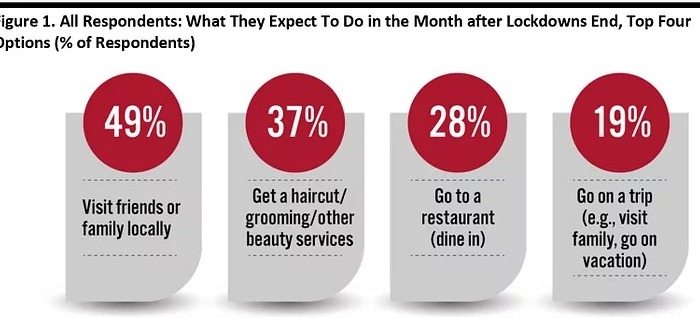US Department of Commerce statistics showed a worst-ever record 9% decrease in April 2020 US retail sales as COVID-19 stay-at-home orders hit the retail sector hard.

One small bright spot was a 20.5% increase in non-store channels, primarily online sales, the second-largest ever recorded. Online grocery sales jumped 13% as consumers shifted their grocery shopping purchases online.
Data from Nielsen and Rakuten Intelligence showed online sales for consumer packaged goods (CPG) rose 45% during April though that was down 5.9% from the shopping frenzy in March 2020 when consumers frantically stocked up on emergency products during the height of the pandemic.
The worst news was the 89.3% freefall in apparel sales as housebound, income-strapped consumers simply stopped buying clothes. We’ve got detailed retail sales numbers and also a look at what consumers are saying their plans are when the lockdown ends.
Crunching April US retail sales numbers
The National Retail Federation (NRF) is trying to remain hopeful.
“As predicted, retail sales were bad in April and lower than in March,” NRF Chief Economist Jack Kleinhenz said. “This should come as no surprise since April was the first full month when most businesses not considered essential were closed, both in retail and across the economy. But month-to-month comparisons provide little insight other than indicating that most of the economy was on lockdown. Now that we’re in mid-May, many businesses are already starting to reopen. Relief payments and pent-up demand should provide some degree of post-shutdown rebound, but spending will be far from normal and may be choppy going forward.”
Key US retail sector sales during April according to the NRF included:

- Online and other non-store sales up 21.2% unadjusted year-over-year and up 8.4% month-over-month seasonally adjusted.
- Grocery and beverage stores up 13.3% unadjusted year-over-year but down 13.1% month-over-month seasonally adjusted.
- Building materials and garden supply stores were up 1.2% unadjusted year-over-year but down 3.5% month-over-month seasonally adjusted.
- Health and personal care stores dropped 10.8% unadjusted year-over-year and down 15.2% month-over-month seasonally adjusted.
- General merchandise stores decreased 13.8% unadjusted year-over-year and down 20.8% month-over-month seasonally adjusted.
- Sporting goods stores were down 48.7% unadjusted year-over-year and down 38% month-over-month seasonally adjusted.
- Electronics and appliance stores plummeted 64.8% unadjusted year-over-year and down 60.6% month-over-month seasonally adjusted.
- Furniture and home furnishings stores were down 66.3% unadjusted year-over-year and down 58.7% month-over-month seasonally adjusted.
- Clothing and clothing accessory stores were down 89.3% unadjusted year-over-year and down 78.8% month-over-month seasonally adjusted.
“These retail sales numbers are not a surprise given the current state of affairs. The vast majority of retail stores have been closed, we are in the midst of historic unemployment and when it comes to personal finances, discretionary spending takes a back seat to essentials said Matthew Shay, NRF President and CEO. ”Prior to this pandemic, retail was setting records in year-over-year growth, employment, and investment. It is a resilient industry serving a smart consumer, and despite today’s report, we know it will be leading our nation’s economic recovery as this crisis recedes.”
Researchers say a return to normal could take longer than anticipated and be more tentative.
Post-pandemic consumer insights
Digital marketing agency Adtaxi says consumer buying habits have changed and predict they’re likely to remain in place as a result of COVID-19. According to their research, 56% of respondents report shopping online more now than ever before, and, more significantly, 53% plan to do more of their shopping online after the crisis is over.

“In this environment of prolonged social distancing, the world is going online to access information, connections, and products they can trust,” said Chris Loretto, EVP of Adtaxi. “This presents a rare opportunity for companies to speak directly to an attentive and thoughtful audience, building product and brand awareness for the present as well as the burgeoning digital future.”
“The longer people are confined to their homes, the more they will need to adapt to utilizing technology for daily life. Those that were previously resistant to online shopping are now learning to adapt and are finding that they can now easily compare products, complete purchases, and have products delivered quickly right to their front door. Much like we see following the holiday shopping season, there tends to be a lingering spike of online shopping meaning people aren’t returning to past behaviors now that they have become more accustomed to buying products online,” said Loretto.
He says consumers may also be reluctant to return to old shopping habits as a matter of safety. Many will be wary of health concerns as businesses continue to implement social distancing measures for shoppers. Hesitation will likely lead to a gradual return to crowded businesses and shopping. The actual in-store shopping experience may look quite different than what we once knew causing many to rely more heavily on internet retailers.

Business should start strategizing now on how they will accommodate the shift in behavior Loretto says. This should include creating omnichannel marketing for consistent messaging across channels, updating site navigation for ease of use as shopping habits evolve, and assessing consumer behavior to meet shoppers based on media consumption. An increase in social media use and streaming services will create more inventory on those channels creating greater targeting capabilities.
“Delivery and pickup will likely be a major part of revenue streams far longer than our formal quarantine period,” Loretto adds. ”There’s been a clear surge in buy online, pick up in-store (BOPIS) search queries and omnichannel businesses have largely been able to stabilize their revenue by optimizing retail locations and inventory for pickup and local deliveries with faster shipping times.”
It’s easier than ever to use social media to get in front of consumers and test new markets quickly and efficiently. Social channels are contributing to quicker conversion particularly when companies target both prospects and previous buyers. Watch for a rise in conversation marketing.
Recovery or more misery: What’s ahead?
Coresight Research has a new survey taken during the week of May 13 that also explores what consumers say they will be doing as the US economy reopens. In a nutshell, consumers are cautious.
73.6% of all respondents expect to avoid some kind of public place or travel after lockdowns end, an increase from 68.4% in the previous week.

The most popular post-lockdown activity will be visiting friends or family locally (49%), according to consumers’ latest expectations. Shopping is a lower priority but spending on services such as haircuts and hairstyles (37%), dining out (28%), or taking a vacation or trip to visit family (19%) were on the list of expected although lower priority activities.
“Even among the leading options for post-lockdown activities, the absolute percentages are relatively low. For example, only slightly more than one in three respondents expect to get a haircut (or other grooming treatment) in their first month of freedom, despite weeks of lockdowns,” the report says.

When it comes the future, 59.2% of consumers surveyed now expect the severe impact of the outbreak to last more than six months from its start, up from 54.0% last week while 92.4% expect the severe impact of the pandemic to last three months or more, up from 87.7% last week.
Despite the small number of high-profile protesters demanding a return to normal in news coverage, the vast majority of consumers clearly remain cautious but hopeful.
That’s valuable insight for sellers and retailers to keep in mind as you plan your reopening strategy.








LET’S CONNECT